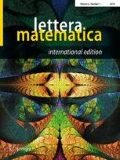In our lives we often fix objectives to be achieved in harmony with our beliefs. The normal processing of memories may cause us to unconsciously shift—backward or forward—the moment when our beliefs were formed and our goals came into focus. But there are exceptions. When, 30 years ago, the adventure of PRISTEM began, no one set the goal of lasting 30 years and being able to publish 100 issues of our Lettera. We are sure of this, there is no possible deformation of the memories. And there is something else we are sure of: we have always tried to make different aspects interact. It was not, therefore, something anomalous to have celebrated these three decades on 19 May 2017 in the Aula Magna of the Università Bocconi with a performance by Sebastiano Lo Monaco of the text Per non morire di mafia (“So as not to die of mafia”), in which the anti-mafia magistrate and present President of the Italian Senate Pietro Grasso recounts excerpts from his life, at the moment when exactly 25 years have passed since the murder of the judges Giovanni Falcone and Paolo Borsellino; afterwards, Nando Dalla Chiesa has interviewed Grasso on contemporary topics.
It was a beautiful day, full of inspirations and thoughts, one with which we are very satisfied. The event was opened by the Rector of Bocconi University, Gianmario Verona, and closed by its President, Senator Mario Monti. There was also a moment when Angelo Guerraggio recalled some salient moments of our history (Fig. 1).
From left to right: Umberto Bottazzini, Pietro Nastasi, Gian Italo Bischi, Pietro Greco, Renato Betti, Simonetta Di Sieno (hidden by Settimo Termini), Settimo Termini, Aldo Brigaglia, Angelo Guerraggio, Pietro Grasso, Francesco La Teana, Giovanni Battimelli, Giovanni Paoloni, Liliana Curcio, Mauro Comoglio, Desiderio Poletto, Luca Alberini, Jacopo De Tullio
We have always stressed the fruitful intertwining of everyday life, civic engagement, research and scientific communication, because we believe that culture is one.
Assuring our readers that we will move forward with the same spirit, let us speak now of the issue of Lettera that you are holding now.
We open with the part 2 of the ongoing series “Communicating mathematics in Europe” by Andrea Capozucca, who this time interviews Alex Bellos about his activity as a populariser of mathematics. Ledo Stefanini, in “Eadem mutata resurgo: A mountaineering tool with a mathematical origin”, discusses the mathematical aspects of a camming device called “friend”. Lucio Cadeddu and Sonia Cannas explain what is meant by “Musical surfaces” by mapping musical canons on surfaces other than the Euclidean plane. “Why do we need the history of mathematical teaching?” is a dialogue between Angelo Guerraggio and Luigi Pepe, who look at the history of mathematics teaching. In “Who was Karl Ferdinand Braun?” Matteo Bischi tells of the tensions between Guglielmo Marconi and Karl Ferdinand Braun, following the award of the joint Nobel Prize for Physics in 1909. Finally, in “From thermodynamics to philosophical tradition: Pierre Duhem’s research between 1891 and 1896”, Stefano Bordoni shows us how Duhem’s urge to reflect on the scientific method grew out of his activity as a scientist.
We hope you enjoy this issue.
Translated from the Italian by Daniele A. Gewurz.
Author information
Authors and Affiliations
Corresponding author
Rights and permissions
About this article
Cite this article
Betti, R., Guerraggio, A. & Termini, S. Letter from the editors. Lett Mat Int 5, 221–222 (2017). https://doi.org/10.1007/s40329-017-0196-y
Published:
Issue Date:
DOI: https://doi.org/10.1007/s40329-017-0196-y


